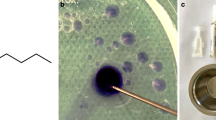Summary
Between 1984 and 1988, 52 brain arteriovenous malformations (AVMs) were embolized in the Radiology Department of the Toronto Western Hospital. 9 were localized in the occipital lobe. There was angiographic follow-up ranging from one to four years. Two embolized AVMs, both occipital, showed revascularisation at 6 months and two years respectively. In one case the embolization had resulted in a complete obliteration of the AVM. In the other, the nidus was reduced by 95%. It is suggested that the occipital lobe, because of its rich vascularity, is more prone than other parts of the brain to produce intense collateralization leading indirectly to resupply of embolized AVMs. Existence of these collaterals may also explain the rarity of visual defects in occipital AVMs. These cases confirm the need for post therapeutic angiographic controls to assess the stability of the results obtained.
Similar content being viewed by others
References
Andrews BJ, Wilson CB (1987) Staged treatment of arteriovenous malformations of the brain. Neurosurgery 21: 314–323
Bank WO, Kerber CW Cromwell LD (1981) Treatment of intracerebral arteriovenous malformations with Isobutyl 2 cyanocrylate: initial clinical experience. Radiology 139: 609–616
Debrun G, Vinuela F, Fox A, Drake CG (1982) Embolization of cerebral arteriovenous malformations with bucrylate. Experience in 46 cases. J Neurosurg 56: 615–627
Luessenhop AJ, Rosa L (1984) Cerebral arteriovenous malformations: indications for and results of surgery, and the role of intravascular techniques. J Neurosurg 60: 14–22
Picard L, Moret J, Lepoire J (1984) Endovascular treatment of intracerebral arteriovenous angiomas: technique, indications and results. J Neuroradiol 11: 9–28
Terbrugge KG, Lasjaunias PL, Chiu MC (1987) Surgical neuroangiography of intracranial vascular malformations. Can J Neurol Sci 14:70–74
Spetzler RF, Martin NA (1988) A proposed grading system for arteriovenous malformations. J Neurosurg 85: 478–483
Vinuela F, Fox A, Pelz D, Debrun G (1986) Angiographic follow up of large cerebral AVMs incompletely embolized with Isobutyl 2-Cyanoacrylate. AJNR 7: 919–925
Vinters HV, Lundie MJ, Kaufmann JCE (1986) Long term pathological follow up of cerebral arteriovenous malformations treated by embolization with bucrylate. N Engl J Med 314: 477–483
Rao VRL, Ravi Madalam K, Gupta AKI, Kumar S, Joseph S (1989) Dissolution of Isobutyl 2 Cyanoacrylate on long term follow up. AJNR 10: 135–141
Author information
Authors and Affiliations
Rights and permissions
About this article
Cite this article
Fournier, D., Terbrugge, K., Rodesch, G. et al. Revascularization of brain arteriovenous malformations after embolization with brucrylate. Neuroradiology 32, 497–501 (1990). https://doi.org/10.1007/BF02426463
Received:
Issue Date:
DOI: https://doi.org/10.1007/BF02426463




